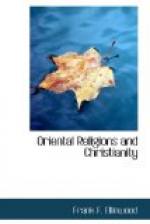In the Northern Buddhist literature—embracing both the “Romantic Legend"[82] and the “Lalita Vistara”—many incidents of Buddha’s childhood are given which show a seeming coincidence with the life of Christ. It is claimed that his birth was heralded by angelic hosts, that an aged sage received him into his arms and blessed him, that he was taken to the temple for consecration, that a jealous ruler sought to destroy him, that in his boyhood he astonished the doctors by his wisdom, that he was baptized, or at least took a bath, that he was tempted, transfigured, and finally received up into heaven. These will be noticed farther on; it is only necessary to say here that the legends giving these details are first at variance with the early canonical history, and second, that they are of such later dates as to place most of them probably within the Christian era.
The Four Peculiar and Characteristic Doctrines of Buddhism.
1. Its peculiar conception of the soul. 2. Its doctrine of Trishna and Upadana. 3. Its theory of Kharma. 4. Its doctrine of Nirvana.
1. The Skandas, five in number, constitute in their interaction what all others than Buddhists regard as the soul. They consist of material properties; the senses; abstract ideas; tendencies or propensities; and the mental powers. The soul is the result of the combined action of these, as the flame of a candle proceeds from the combustion of its constituent elements. The flame is never the same for two consecutive moments. It seems to have a perpetuated identity, but that is only an illusion, and the same unreality pertains to the soul. It is only a succession of thoughts, emotions, and conscious experiences. We are not the same that we were an hour ago. In fact, there is no such thing as being—there is only a constant becoming. We are ever passing from one point to another throughout our life; and this is true of all beings and all things in the universe. How it is that the succession of experiences is treasured up in memory is not made clear. This is a most subtle doctrine, and it has many points of contact with various speculations of modern times. It has also a plausible side when viewed in the light of experience, but its gaps and inconsistencies are fatal, as must be seen when it is thoroughly examined.
2. The second of the cardinal doctrines is that of Trishna. Trishna is that inborn element of desire whose tendency is to lead men into evil. So far, it is a misfortune or a form of original sin. Whatever it may have of the nature of guilt hangs upon the issues of a previous life. Upadana is a further stage in the same development. It is Trishna ripened into intense craving by our own choice and our own action. It then becomes uncontrollable and is clearly a matter of guilt. Now, the momentum of this Upadana is such that it cannot be arrested by death. Like the demons of Gadara it must again become incarnate, even though it should enter the body of a brute. And this transitional something, this restless moral or immoral force which must work out its natural results somehow and somewhere, and that in embodied form projects into future being a residuum which is known as Kharma.




